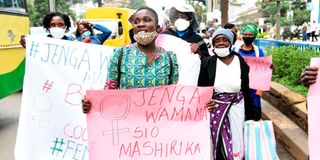Women in informal sector face inequality, social exclusion

Women working in the informal sector demonstrate along Kenyatta Avenue, Nairobi. Women who depend on the sector for their daily earnings face heightened gender inequality and social exclusion, a report says.
What you need to know:
- The Gender Equality and Social Inclusion (Gesi) Analysis report indicates that in Kenya, women make up 66 per cent of the informal workforce, while across Africa, the figure stands at 88 per cent.
- More women than men are employed in Kenya in both formal and informal sectors, according to the report.
Women who depend on the informal sector for their daily earnings face heightened gender inequality and social exclusion, a report says.
The report, Gender Equality and Social Inclusion Analysis conducted by the British High Commission (Nairobi) between July 2022 and March 2023, indicates that in Kenya, women make up 66 per cent of the informal workforce, while across Africa, the figure stands at 88 per cent.
More women than men are employed in Kenya in both formal and informal sectors, according to the report. However, women in the informal sector were found to have limited protection against dismissal and limited or no paid sick leave or access to social protection.
“Due to the precarious nature of the work women carry out in the informal sector and the dependency on public spaces and social interaction, women were at greater risk of the health shocks caused by the Covid-19 pandemic,” states the report.
Job loss
“Evidence shows that women were more likely than men to lose their job and income during the pandemic with the Kenya National Bureau of Statistics showing that 51.2 per cent of women lost their jobs.”
The analysis found that even before the Covid-19 crisis, women carried out over twice as much unpaid care and domestic work as men. And this unequal division of labour significantly limited women's abilities to earn an income and realise their human rights.
“Despite its substantial socioeconomic contribution to national well-being, women's care work remains invisible and unaccounted for in economic decision making.
"The pandemic increased health and care needs and school closures, further increasing the unequal burden of care work on women and girls in Kenya. The increase was higher for unpaid care work related to minding children and caring for children.”
Other vulnerable groups
Besides women working in informal sectors, women and girls with disabilities, adolescent girls, women from low socioeconomic backgrounds, women refugees and women in arid and semi-arid lands were cited as experiencing the highest levels of gender inequality and social exclusion.
To tackle the exclusion, the analysis recommended working with key institutions such as the new women's rights agency and the National Council of Gender Equality. It also called for capacity building and funding of women's rights organisations.
This is an addition to the implementation of policies and legislation that impact women and girls and other key populations while improving data availability on the nature and prevalence of exclusion.





